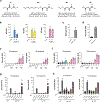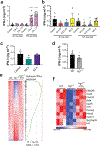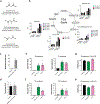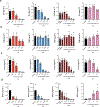Comparative evaluation of itaconate and its derivatives reveals divergent inflammasome and type I interferon regulation in macrophages
- PMID: 32694786
- PMCID: PMC7378276
- DOI: 10.1038/s42255-020-0210-0
Comparative evaluation of itaconate and its derivatives reveals divergent inflammasome and type I interferon regulation in macrophages
Abstract
Following activation, macrophages undergo extensive metabolic rewiring1,2. Production of itaconate through the inducible enzyme IRG1 is a key hallmark of this process3. Itaconate inhibits succinate dehydrogenase4,5, has electrophilic properties6 and is associated with a change in cytokine production4. Here, we compare the metabolic, electrophilic and immunologic profiles of macrophages treated with unmodified itaconate and a panel of commonly used itaconate derivatives to examine its role. Using wild-type and Irg1-/- macrophages, we show that neither dimethyl itaconate, 4-octyl itaconate nor 4-monoethyl itaconate are converted to intracellular itaconate, while exogenous itaconic acid readily enters macrophages. We find that only dimethyl itaconate and 4-octyl itaconate induce a strong electrophilic stress response, in contrast to itaconate and 4-monoethyl itaconate. This correlates with their immunosuppressive phenotype: dimethyl itaconate and 4-octyl itaconate inhibited IκBζ and pro-interleukin (IL)-1β induction, as well as IL-6, IL-10 and interferon-β secretion, in an NRF2-independent manner. In contrast, itaconate treatment suppressed IL-1β secretion but not pro-IL-1β levels and, surprisingly, strongly enhanced lipopolysaccharide-induced interferon-β secretion. Consistently, Irg1-/- macrophages produced lower levels of interferon and reduced transcriptional activation of this pathway. Our work establishes itaconate as an immunoregulatory, rather than strictly immunosuppressive, metabolite and highlights the importance of using unmodified itaconate in future studies.
Conflict of interest statement
Competing interests statement
The authors declare that they have no competing interests.
Figures











References
Publication types
MeSH terms
Substances
Grants and funding
LinkOut - more resources
Full Text Sources
Other Literature Sources

